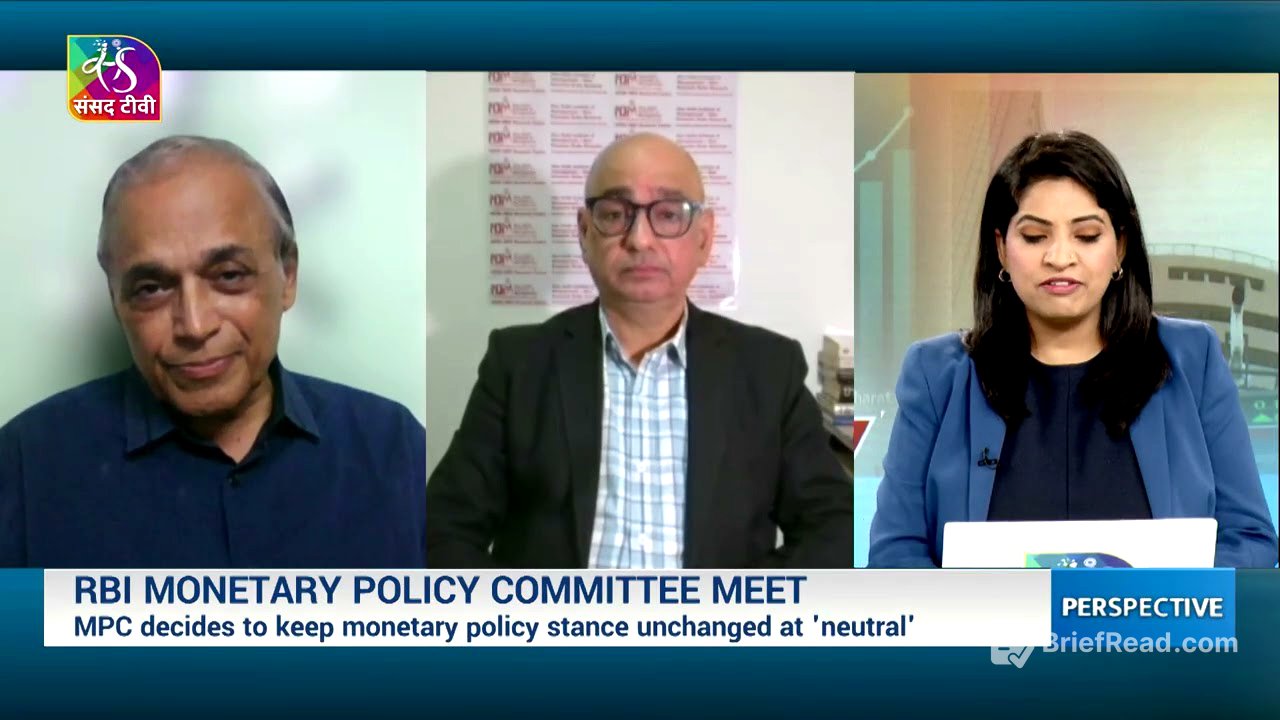TLDR;
The Reserve Bank of India (RBI) has released its latest monetary policy report, keeping the repo rate unchanged at 5.5% with a neutral stance. The RBI has revised India's GDP growth forecast upwards to 6.8% for FY 2025-26 and lowered its inflation projection to 2.6%. Experts discuss the factors driving domestic growth, price stability, and the implications for the Indian economy's future. Key points include:
- RBI's calibrated approach amidst global headwinds.
- Focus on resilience of the banking sector and ease of doing business.
- Importance of GST reforms and monsoon for economic growth.
- Need to address challenges in credit growth and external deficits.
Introduction [0:14]
Tina from Sansad TV introduces a discussion on the RBI's latest monetary policy report. The report follows the 57th meeting of the Monetary Policy Committee (MPC). The central bank has maintained the repo rate at 5.5% with a neutral stance, a unanimous decision by the MPC. RBI Governor Sanjay Malhotra expressed confidence in India's economic momentum. The RBI has revised India's GDP growth forecast for FY 2025-26 to 6.8% and lowered its inflation projection to 2.6%. Dr. Ashok Kag, former advisor, Reserve Bank of India, and Dr. SP Sharma, chief economist at the NDIM Neo Research Center, join the discussion to decode the RBI's outlook.
MPC Decision and Key Considerations [1:45]
Dr. Nag explains that repo rate decisions are based on inflation control. With a decline in the inflation rate, there's less need to further reduce the repo rate. He points out that despite a 100 basis point reduction in the repo rate over the past year, banks haven't fully passed on the benefits to consumers. Dr. Nag highlights the importance of expected credit loss, which RBI plans to introduce, requiring banks to keep capital for potential future defaults. He also mentions the significance of external deficits and the need to address them.
RBI's Calibrated Step Amidst Global Headwinds [6:46]
Dr. Sharma believes the RBI has taken a calibrated step amidst global headwinds. India is resilient, with growth reaching 7.8% to 8% in the first quarter and inflation falling to around 1.5% to 2.1%. Good monsoon and GST reforms support the Indian economy. RBI's stable rates aim to make the economy more resilient against global issues like geopolitical tensions and Trump tariffs. The anticipated growth for the coming quarters is around 7%, with an overall growth increase from 6.4% to 6.8%. India's growth is more than double the global growth rate of 3%. Measures to improve the resilience of the banking sector, capital flow, ease of doing business, foreign exchange management, consumer satisfaction, and internationalization of the rupee have been announced.
Domestic Growth Drivers and GST Reforms [9:55]
Dr. Sharma emphasizes that GST reforms are significant for India's consumption growth. Consumption increases demand, leading to factory expansion and job creation. He believes GST 2.0 will boost economic growth, supporting producers, exporters, and manufacturers. Good monsoon increases farmers' incomes, further driving demand. GST reforms are expected to contribute 40 to 50 basis points to the growth trajectory.
Global Confidence in India's Growth [12:07]
Dr. Nag notes that various global agencies reaffirm India's growth trajectory, projecting growth between 6.5% and 6.8%. India's growth looks better compared to struggling Western countries. However, he raises concerns about the slower credit growth in the private sector despite repo rate reductions. He also points out that external deficits are improving due to remittances, but rising tariffs could pose future challenges. RBI's role is to maintain stability and facilitate currency exchange for international business.
Simplifying Rules for Business and Improving Credit Access [17:48]
Dr. Sharma highlights the importance of measures to increase the competitiveness of the Indian economy. These include strengthening the banking sector, improving capital flow, and easing the process of doing business. He notes that while India's ranking in ease of doing business has improved, the benefits should be felt at the factory level through reduced costs of finance, logistics, compliance, and land. Simplifying foreign exchange management is also crucial for exporters and importers.
Rupee Volatility and RBI's Intervention [20:26]
Dr. Nag explains that the RBI intervenes when there is high volatility in the rupee's exchange rate. He anticipates that foreign exchange deficits could pose a problem if merchant deficits increase due to tariffs. RBI can facilitate the use of the rupee in international trade to ease business transactions. He also expresses his opinion that the USA is in decline, and India should not be overly reliant on it.









